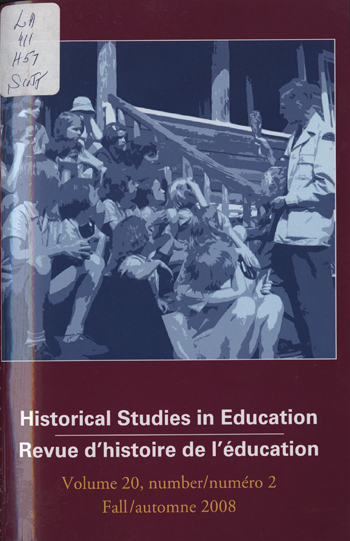Publiée
December 12, 2008
Mention de droit d'auteur
Droit d’auteur et politique de libre accès
Historical Studies in Education/Revue d’histoire de l’éducation (HSE/RHÉ) offre un accès libre et immédiat à son contenu conformément au Budapest Open Access Initiative. Les utilisateurs sont autorisés à lire, télécharger, copier, distribuer, imprimer, faire une recherche ou établir un lien vers le texte intégral de nos articles. Tout le contenu de la revue est en accès libre et sans frais pour l’utilisateur ou son institution. Il n’y a pas de frais de traitement facturé aux auteurs pour la publication de leur article. L’accès immédiat et libre au contenu repose sur le principe que la recherche librement accessible au public favorise un plus grand échange des connaissancesau niveau mondial. Les utilisateurs ne peuvent pas modifier les publications du HSE/RHÉ ni les utiliser à des fins commerciales sans avoir demandé l’autorisation préalable de l’éditeur et de l’auteur.
Les auteurs qui publient avec notre revue acceptent les termes suivants :
a. Les auteurs conservent le droit d’auteur et accordent le droit de première publication à HSE/RHÉ.
b. Les auteurs souhaitant conclure des arrangements contractuels ultérieurs distincts, commerciaux ou non commerciaux, pour la distribution non exclusive de la version de leur travail publié par la revue (par exemple, le publier dans un dépôt institutionnel ou le publier dans un livre), doivent demander la permission de la revue. Les publications ultérieures doivent inclure une mention indiquant sa parution initiale dans HSE/RHÉ.
c. Les auteurs souhaitant réviser, modifier, ou développer leurs travaux publiés dans HSE/RSÉ doivent demander la permission de la revue pour publier le matériel révisé. Toute publication subséquente doit inclure une mention sur la forme initiale de l’article paru dans HSE/RHÉ.
Résumé
Established in 1822 “for the education of the children of the labouring
class,” Montreal’s British and Canadian School Society enabled working families of various ethnic backgrounds to have their children receive free schooling in a non-denominational setting. Located at the edge of the old town in a purpose-built structure, the British and Canadian School figured prominently within the array of early educational establishments studied by Bruce Curtis, Andrée Dufour, and others. In the wake of the rebellions in Lower Canada and the resulting separation of institutions along religious lines, the school became increasingly identified with the Protestant community and in 1866 was formally incorporated into the city’s emerging Protestant school system. Despite this apparent loss of its non-denominational character, the school continued to attract substantial numbers of children from Catholic and Jewish families, the latter resulting from an agreement between the synagogues and the school board. The school also retained its particular attraction for working-class families, who appear to have applied regularly with some determination to see their children exposed to learning even if only for short periods. A Registry of Admissions to the British and Canadian School from the mid-1870s reveals a pattern whereby schooling formed part of long-term strategy within the working class family economy; as such, it sheds light on the work of historians such as Bettina Bradbury and Terry Copp. The Registry also permits analysis of the school population by gender, ethnicity, age, place of residence, and academic competence.
